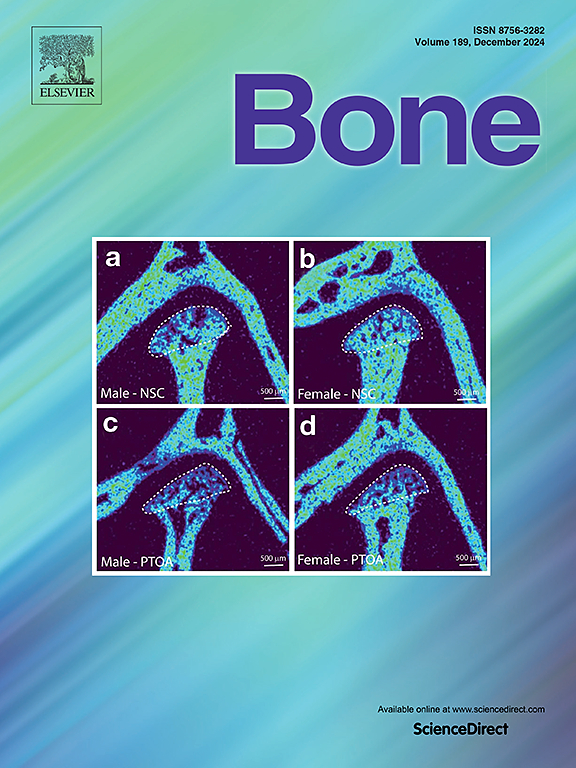The effect of celecoxib and muMab911 on strain adaptive bone remodeling and fracture repair in female mice: implications for rapidly progressive osteoarthritis
IF 3.5
2区 医学
Q2 ENDOCRINOLOGY & METABOLISM
引用次数: 0
Abstract
Debilitating pain is the primary clinical feature of osteoarthritis (OA) that drives the enormous healthcare costs. Osteoarthritis-related pain is often treated with non-steroidal anti-inflammatory drugs (NSAIDs), which effectively relieve pain and inflammation by inhibition of prostaglandin synthesis. Antibodies directed against nerve growth factor (NGF) were tested some time ago as an alternative potential analgesic for musculoskeletal pain, including osteoarthritis-related pain. Unfortunately, clinical development of these drugs was put on hold due to adverse outcomes – primarily rapidly progressive osteoarthritis. Both prostaglandin synthesis and NGF have been implicated as critical mediators of strain adaptive bone remodeling, which may play a role in rapid osteoarthritis progression. Therefore, this study was designed to investigate the effects of celecoxib, an NSAID, and muMab911, an anti-NGF antibody, as well as the combination therapy on strain adaptive bone remodeling, bone mass and geometry, and bone healing in a murine model. Adult female C57BL/6 J mice received celecoxib through drinking water, up to 3 IP injections of muMab911, or both treatments over a period of two weeks. As expected, all treatments were effective for relieving injury-associated pain. Consistent with previous studies, we found that celecoxib alone and in combination with muMab911 impaired periosteal load-induced bone formation induced by axial forelimb compression. Furthermore, both treatments had minimal effects on osteoblast and osteocyte populations, bone structural and material properties, and cortical and trabecular bone mass. Moreover, treatment did not impair fracture healing or callus morphology, though both treatments suppressed NGF expression during healing. Together, these findings suggest that celecoxib and anti-NGF therapy diminish strain adaptive bone remodeling without broadly compromising bone mass or repair, potentially contributing to the accelerated OA progression observed clinically by weakening the subchondral bone's adaptive capacity.
塞来昔布和muMab911对雌性小鼠应变适应性骨重塑和骨折修复的影响:对快速进行性骨关节炎的影响
衰弱性疼痛是骨关节炎(OA)的主要临床特征,导致巨大的医疗费用。骨关节炎相关疼痛通常使用非甾体抗炎药(NSAIDs)治疗,这些药物通过抑制前列腺素的合成有效地缓解疼痛和炎症。不久前,针对神经生长因子(NGF)的抗体被测试为肌肉骨骼疼痛(包括骨关节炎相关疼痛)的替代潜在镇痛药。不幸的是,由于不良后果——主要是迅速进展的骨关节炎,这些药物的临床开发被搁置了。前列腺素合成和神经生长因子都被认为是应变适应性骨重塑的关键介质,这可能在骨关节炎的快速进展中起作用。因此,本研究旨在探讨塞来昔布(一种非甾体抗炎药)和抗ngf抗体muMab911及其联合治疗对小鼠模型应变适应性骨重塑、骨量和几何形状以及骨愈合的影响。成年雌性C57BL/ 6j小鼠在两周内通过饮水、最多3次免疫注射muMab911或两种治疗方式给予塞来昔布。正如预期的那样,所有的治疗方法都能有效地缓解损伤相关的疼痛。与先前的研究一致,我们发现塞来昔布单独使用和与muMab911联合使用会损害骨膜负荷诱导的轴向前肢压迫所致的骨形成。此外,两种治疗对成骨细胞和骨细胞数量、骨结构和材料特性以及皮质和骨小梁骨量的影响都很小。此外,尽管两种治疗均抑制愈合过程中NGF的表达,但治疗并未损害骨折愈合或骨痂形态。综上所述,这些发现表明,塞来昔布和抗ngf治疗可减少应变适应性骨重塑,但不会广泛影响骨量或修复,可能会通过削弱软骨下骨的适应能力而加速骨性关节炎的进展。
本文章由计算机程序翻译,如有差异,请以英文原文为准。
求助全文
约1分钟内获得全文
求助全文
来源期刊

Bone
医学-内分泌学与代谢
CiteScore
8.90
自引率
4.90%
发文量
264
审稿时长
30 days
期刊介绍:
BONE is an interdisciplinary forum for the rapid publication of original articles and reviews on basic, translational, and clinical aspects of bone and mineral metabolism. The Journal also encourages submissions related to interactions of bone with other organ systems, including cartilage, endocrine, muscle, fat, neural, vascular, gastrointestinal, hematopoietic, and immune systems. Particular attention is placed on the application of experimental studies to clinical practice.
 求助内容:
求助内容: 应助结果提醒方式:
应助结果提醒方式:


